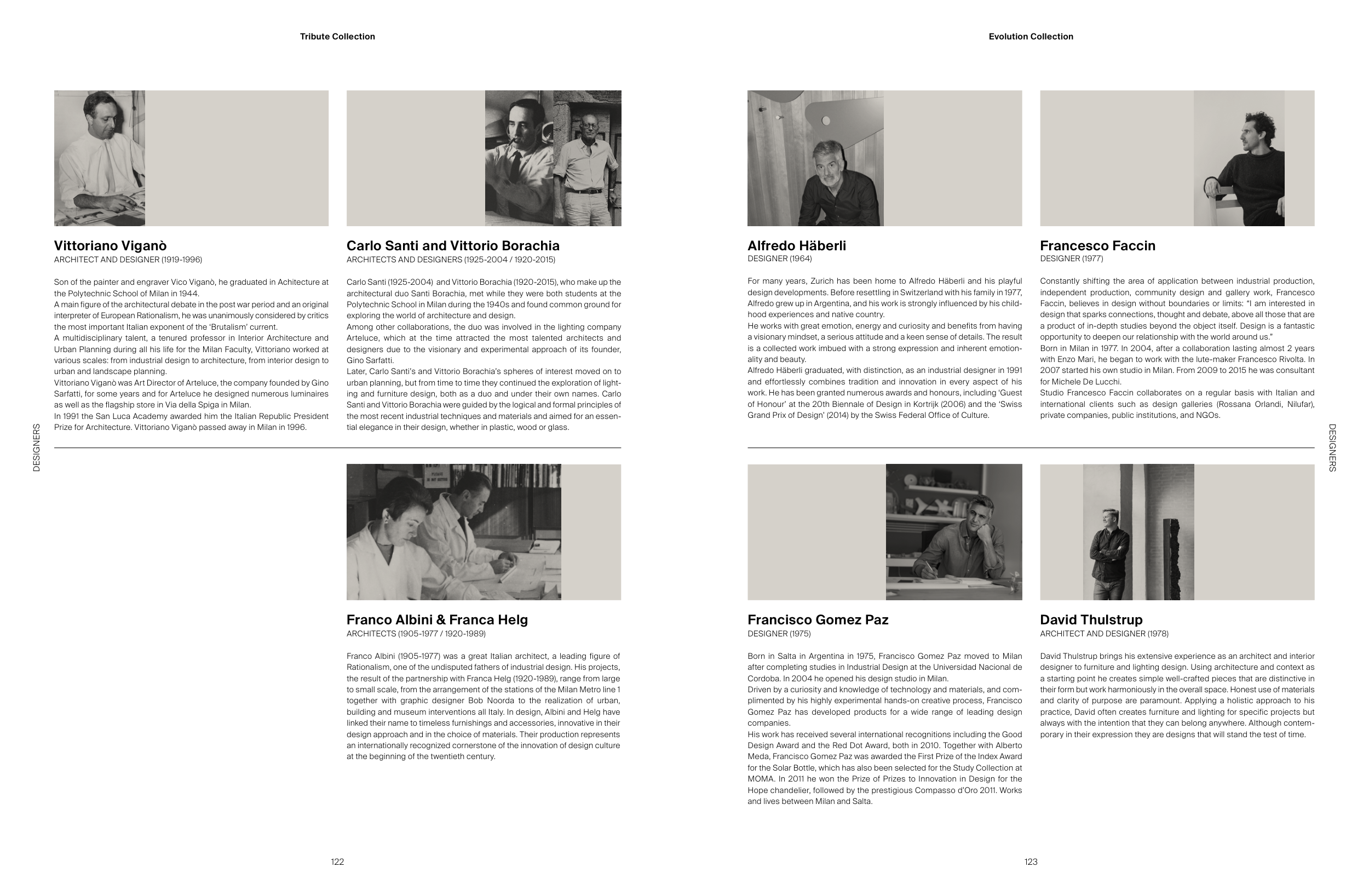Vittoriano Viganò
ARCHITECT AND DESIGNER (1919-1996)
Son of the painter and engraver Vico Viganò, he graduated in Achitecture at
the Polytechnic School of Milan in 1944.
A main figure of the architectural debate in the post war period and an original
interpreter of European Rationalism, he was unanimously considered by critics
the most important Italian exponent of the ‘Brutalism’ current.
A multidisciplinary talent, a tenured professor in Interior Architecture and
Urban Planning during all his life for the Milan Faculty, Vittoriano worked at
various scales: from industrial design to architecture, from interior design to
urban and landscape planning.
Vittoriano Viganò was Art Director of Arteluce, the company founded by Gino
Sarfatti, for some years and for Arteluce he designed numerous luminaires
as well as the flagship store in Via della Spiga in Milan.
In 1991 the San Luca Academy awarded him the Italian Republic President
Prize for Architecture. Vittoriano Viganò passed away in Milan in 1996.
Alfredo Häberli
DESIGNER (1964)
For many years, Zurich has been home to Alfredo Häberli and his playful
design developments. Before resettling in Switzerland with his family in 1977,
Alfredo grew up in Argentina, and his work is strongly influenced by his child-
hood experiences and native country.
He works with great emotion, energy and curiosity and benefits from having
a visionary mindset, a serious attitude and a keen sense of details. The result
is a collected work imbued with a strong expression and inherent emotion-
ality and beauty.
Alfredo Häberli graduated, with distinction, as an industrial designer in 1991
and effortlessly combines tradition and innovation in every aspect of his
work. He has been granted numerous awards and honours, including ‘Guest
of Honour’ at the 20th Biennale of Design in Kortrijk (2006) and the ‘Swiss
Grand Prix of Design’ (2014) by the Swiss Federal Office of Culture.
Francesco Faccin
DESIGNER (1977)
Constantly shifting the area of application between industrial production,
independent production, community design and gallery work, Francesco
Faccin, believes in design without boundaries or limits: “I am interested in
design that sparks connections, thought and debate, above all those that are
a product of in-depth studies beyond the object itself. Design is a fantastic
opportunity to deepen our relationship with the world around us.”
Born in Milan in 1977. In 2004, after a collaboration lasting almost 2 years
with Enzo Mari, he began to work with the lute-maker Francesco Rivolta. In
2007 started his own studio in Milan. From 2009 to 2015 he was consultant
for Michele De Lucchi.
Studio Francesco Faccin collaborates on a regular basis with Italian and
inter national clients such as design galleries (Rossana Orlandi, Nilufar),
private companies, public institutions, and NGOs.
Carlo Santi and Vittorio Borachia
ARCHITECTS AND DESIGNERS (1925-2004 / 1920-2015)
Carlo Santi (1925-2004) and Vittorio Borachia (1920-2015), who make up the
architectural duo Santi Borachia, met while they were both students at the
Polytechnic School in Milan during the 1940s and found common ground for
exploring the world of architecture and design.
Among other collaborations, the duo was involved in the lighting company
Arteluce, which at the time attracted the most talented architects and
designers due to the visionary and experimental approach of its founder,
Gino Sarfatti.
Later, Carlo Santi’s and Vittorio Borachia’s spheres of interest moved on to
urban planning, but from time to time they continued the exploration of light-
ing and furniture design, both as a duo and under their own names. Carlo
Santi and Vittorio Borachia were guided by the logical and formal principles of
the most recent industrial techniques and materials and aimed for an essen-
tial elegance in their design, whether in plastic, wood or glass.
Francisco Gomez Paz
DESIGNER (1975)
Born in Salta in Argentina in 1975, Francisco Gomez Paz moved to Milan
after completing studies in Industrial Design at the Universidad Nacional de
Cordoba. In 2004 he opened his design studio in Milan.
Driven by a curiosity and knowledge of technology and materials, and com-
plimented by his highly experimental hands-on creative process, Francisco
Gomez Paz has developed products for a wide range of leading design
companies.
His work has received several international recognitions including the Good
Design Award and the Red Dot Award, both in 2010. Together with Alberto
Meda, Francisco Gomez Paz was awarded the First Prize of the Index Award
for the Solar Bottle, which has also been selected for the Study Collection at
MOMA. In 2011 he won the Prize of Prizes to Innovation in Design for the
Hope chandelier, followed by the prestigious Compasso d’Oro 2011. Works
and lives between Milan and Salta.
Franco Albini & Franca Helg
ARCHITECTS (1905-1977 / 1920-1989)
Franco Albini (1905-1977) was a great Italian architect, a leading figure of
Rationalism, one of the undisputed fathers of industrial design. His projects,
the result of the partnership with Franca Helg (1920-1989), range from large
to small scale, from the arrangement of the stations of the Milan Metro line 1
together with graphic designer Bob Noorda to the realization of urban,
building and museum interventions all Italy. In design, Albini and Helg have
linked their name to timeless furnishings and accessories, innovative in their
design approach and in the choice of materials. Their production re presents
an internationally recognized cornerstone of the innovation of design culture
at the beginning of the twentieth century.
David Thulstrup
ARCHITECT AND DESIGNER (1978)
David Thulstrup brings his extensive experience as an architect and interior
designer to furniture and lighting design. Using architecture and context as
a starting point he creates simple well-crafted pieces that are distinctive in
their form but work harmoniously in the overall space. Honest use of materials
and clarity of purpose are paramount. Applying a holistic approach to his
practice, David often creates furniture and lighting for specific projects but
always with the intention that they can belong anywhere. Although contem-
porary in their expression they are designs that will stand the test of time.
122
123
Tribute Collection
Evolution Collection
DESIGNERS
DESIGNERS


